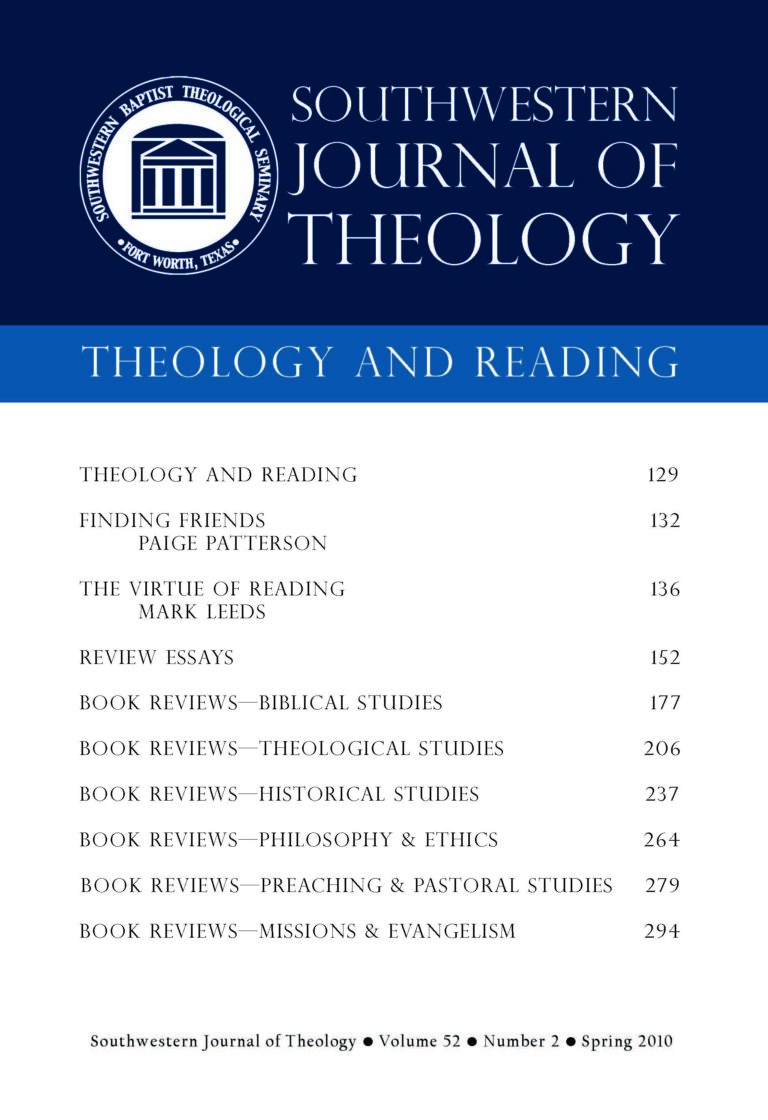
Theology and Reading
Southwestern Journal of Theology
Volume 52, No. 2 – Spring 2010
Managing Editor: Malcolm B. Yarnell III
Edited by Fred Sanders & Klaus Issler. Nashville: B&H Academic, 2007. 244 pages. Softcover, $24.99.
Evangelical scholars Fred Sanders and Klaus Issler have edited a collection of essays aimed at providing an interdisciplinary introduction to Christology. The collection includes essays written from the perspectives of church history and philosophy as well as the various theological disciplines—systematic, practical, and biblical. Together they seek to explore truths about Jesus that can only be understood in trinitarian perspective.
The collection provides practical helps before and after each chapter to assist the reader towards a better understanding of the content of each chapter. These include chapter summaries, axioms for understanding Christology, key terms for study, reflective questions, and a short bibliography for further reading. The study questions are relatively simple although broad enough to serve as conversation starters in a classroom setting.
Fred Sanders introduces the collection with an essay entitled, “Chalcedonian Categories for the Gospel Narrative.” Sanders provides a basic introduction to the early Christological controversies and to the overall context of the first five ecumenical councils. For the reader unfamiliar with the terms and history, this chapter will provide enough grounding for a basic understanding of the following chapters. The chapter ends with Sanders describing how the various contributions fit within the framework of early Christological discussion.
J. Scott Horrel seeks to tighten our understanding of the relations between the immanent and economic Trinity with his essay, “The Eternal Son of God in the Social Trinity.” Horrell argues convincingly that all speculations concerning the immanent Trinity must be filtered through the Scriptures. As such, he ends his essay with a discussion of the clear biblical evidence supporting an eternal ordering of the persons of the Godhead.
Donald Fairbairn’s contribution, “The One Person Who Is Jesus Christ,” makes a persuasive argument against the common notion that Chalcedon resulted as a compromise between the Alexandrian and Antiochene schools of thought. Through a brief analysis of writers within the so-called Antiochene school, such as John Chrysostom and John of Antioch, Fairbairn shows that their writing was more in line with Cyril of Alexandria than with Theodore and Nestorius. Thus, Antioch did not have a school of thought, and the council was “an expression of . . . outrage that most of the church felt toward the unacceptable Christology of a tiny minority of people” (80). Fairbairn argues for framing the debates soteriologically instead of terminologically, and ends his essay showing the continuing influence of Cyril of Alexandria’s thought.
In his essay, “One Person, Two Natures,” Garrett J. DeWeese argues for an understanding of the Chalcedonian language, person and nature, within a contemporary model. The essay interacts with contemporary analytic philosophy and requires a basic understanding of philosophy to fully understand his arguments. DeWeese critiques traditional understandings of person and nature, showing how Platonists, Aristotelians, Thomists and nominalists have all interpreted that language differently. This frames the discussion in historical perspective and provides a path for DeWeese to argue that a contemporary model is both faithful to the terminology of Chalcedon and also provides new avenues for Scriptural insight and study.
Bruce Ware’s contribution, “Christ’s Atonement,” shows the necessity of understanding Christ’s atoning work within trinitarian perspective. Ware excels at showing how Scripture should influence all thinking and speculation on the Trinity. Ware also makes a case for eternal order within the Trinity, and, together with Horrell’s essay, forms a coherent and thoroughly scriptural argument. Ware argues from Scripture to illustrate that without the work of the Father and the Spirit, Christ could not have effectively atoned for humanity. Thus, the atonement must be understood in trinitarian perspective.
The concluding chapter, “Jesus’ Example,” by Klaus Issler, gives an interdisciplinary argument for understanding Jesus’ reliance on the Spirit and Father as the perfect example for the church. Drawing from the works of biblical, practical, and systematic theologians, as well as philosophers and historians, Issler shows conclusively that Jesus, in his human nature, was predominantly dependent on the Father and Spirit. Issler then argues that Jesus’ growth in wisdom and stature as a child provides an example for believers to grow in our trust and dependence upon the Godhead.
In conclusion, this collection of essays would serve as a good Christological introduction for a college or graduate level course in theology. As a whole, the collection provides the reader with a good introduction to the various fields that interact with Christology and also challenges the reader to pursue the questions discussed with greater depth.





